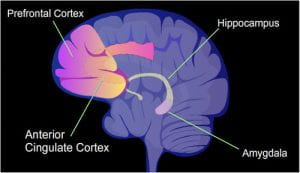Created by; Julie Boulais
By simply living the everyday life in today’s society, stress is merely inevitable to escape. Luckily, it can be reduced so much through meditation to the point where it can actually help rejuvenate the mind to live a longer and healthier life. Using constant meditation, you can find your inner peace and obtain relaxation within your mind. This state of mind has a wide range of positive health benefits that can’t be found in a special pill prescribed by your doctor. In this text I will discuss the benefits of Meditation and how it can boost brain volume, reduce brain aging, improve concentration and regulate stress.
The brain can change within its structural form from meditation by thickening the hippocampus that is known to control the memory and learning aspects, as well as the person being able to control their emotions in an easier manner which can result in a decrease of negative emotions and stress (Welch & M.D Laube, 2018). People who have PTSD and other mental health disorders can benefit from this by being able to more easily articulate how they feel especially when they are stressed. Also, the amygdala was found to be decreased within volume as well, showing signs of reduced anxiety/depression and stress.
Besides some of the brain structures being able to grow/shrink, the brain’s neurological functions also increase with a boost of benefits. Meditation reduces aging within the brain, the white matter (axons connecting different parts of grey matter) and grey matter (the brain’s neurological cells) are preserved for longer. For 20 years researchers examined the brains of 50 volunteers, some who had meditated and some who hadn’t, concluded that both groups had a loss of grey brain matter (Welch & M.D Laube, 2018). But the people who had meditated lost their grey brain matter a lot slower which means they were able to keep neural connections for longer, for future years to come. (Welch & M.D Laube, 2018).
An interesting find is that lobsters may hold the secret to bringing meditative youth to the aging brain. Every living creature has DNA filled with chromosomes, these chromosomes are protected by long telomeres at the end of each one, kind of like the small plastic coverings at the ends of shoelaces. The telomeres protect the DNA and chromosomes from instant wear and tear that cause them to shorten their length over time. When these telomeres shorten, it causes changes in the body and brain with mentality and muscle function among other bodily functions that decrease with aging.

Telomeres are like the protective capsules on the ends of shoelaces. They help protect DNA and chromosomes from wear and tear over years.
But unlike any other creature on earth, the lobster’s telomeres do not wear and tear as they “age” because these sea creatures have a special enzyme called telomerase that they produce constantly at a high flow rate throughout their lives(EOC Institute LLC, 2020). It helps the telomeres remain perfectly long and healthy on the ends of the chromosomes. As the lobsters “age” they end up growing bigger, stronger and more fertile unlike humans who have the opposite affect with aging due to the gradual shutting down of that production. Lobsters only die if they are eaten, severely injured or have a disease, some lobsters are found to have lived over 140 years (EOC Institute LLC, 2020). So how can people obtain this immortal behavior like the lobsters? Well, one study suggests that meditation could be the start of a longer healthier life. After just 3 months of meditation, their bodies were able to produce about 40% more telomerase for every ten thousand cells compared to the subjects who did not meditate (EOC Institute LLC, 2020).
Another brain function that can be improved by meditation is memory and concentration. The brain produces BDNF (Brain Derived Neurotrophic Factor) which is important for long term and short-term memory. But as we age, there can be a shortage of BDNF which leads to many metal diseases such as dementia, Huntington’s, Alzheimer’s and more. A Psychology professor in the year of 2017 at the University of Southern California by the name of Rael Cahn M.D did an experiment using nearly 40 people, testing before a 3 month trial of meditation and after the 3 months of meditation (EOC Institute LLC, 2020). By the end of the experiment they discovered that within just those three months the individuals increased their Brain Derived Neurotrophic Factor (BDNF) levels by 280%, from 2513 to 7039 pg/ml (EOC Institute LLC, 2020). BDNF helps keep the brain functioning at an all-time high, especially helping the long and short term memory, as well as the learning of new tasks by stimulating “fresh” neurons and their firing synapses to continuing making strong neural connections. If you don’t use it, you’ll lose it. It seems as if meditation can help prevent Huntington’s, Alzheimer’s, Dementia and/or other neurological diseases that just years ago were said they couldn’t be prevented. No, it’s not a magic pill or vaccination that you can take, you have to put in the work for this one in order to receive the reward. Even if you aren’t concerned with these diseases possibly being in your future meditation can also help with better keeping focus in today’s busy world. Helps to hone in the wandering thoughts during times of needed concentration or prior to falling sleep (EOC Institute LLC, 2020).
Lastly, meditation can be used to help reduce the amount of stress created on a daily basis. Helps to keep the body and mind in check, in more of a state of homeostasis, where the mind can learn how to overcome stressors. In the medical field under osteopathic medicine (a holistic approach in the medical field) have discovered a few techniques that help decrease stress on the mind and body known as Osteopathic Manipulative Treatment (OMT). Muscular tension can be caused around the skull through neural connections. One technique called Suboccipital inhibition (decompression) to reduce the tension through a parasympathetic notion by activating the vagus nerve in order to bring homeostasis to the autonomic nervous system. This is through the technique of rib raising, occurring at the release of the costotransverse articulation and taking affect throughout the entire body. These OMT techniques can help the patient’s of osteopathic professionals properly care for their body, mind and spirit “by supporting their physiologic resilience and homeostasis during stressful times.” (Emmet, Nuño & Pierce-Talsma, 2018).
I feel these topics are important to discuss because people should know effective ways on how to deal with potentially dangerous stress that can shorten their lives. Without these methods of meditation people can become overly consumed by the everyday stressors in life. The big and the small stressors will eventually add up for most people by the time they enter into late adulthood and cause potential for major health issues. Some of these issues could be as simple as high blood pressure or as severe as coronary artery disease, dementia, Alzheimer’s or eventually lead to a heart attack. I feel meditation methods are very helpful in reducing these outcomes and helping the meditator learn how to not only adapt and accept to stressors but handle them in a more calming manner. Meditation is a wonderful way to escape stress for brief moments that help the brain overcome and adapt to it and remain youthful. I also find it very interesting that lobsters found to key to living a long happy life by creating a constant flow of realizing the enzyme telomerase. And how people who meditate also release that enzyme as well, making their brain remain more youthful than those who don’t meditate at all.
Cited sources:
Emmet, D., Nuño, V., & Pierce-Talsma, S. (2018, February 1). OMT to Address the Physiologic Effects of Stress. Retrieved from https://jaoa.org/article.aspx?articleid=2671440
EOC Institute LLC. (2020). Super Longevity: How Meditation Dramatically Extends Human Life. Retrieved from https://eocinstitute.org/meditation/4-top-ways-meditation-is-the-best-anti-aging-longevity-tool/
Welch, A., & M.D Laube, J. (2018, June 25). 4 Ways Meditation Changes the Brain: Everyday Health. Retrieved from https://www.everydayhealth.com/meditation/ways-changes-brain/
Merkes, M. (2010, September 6). Mindfulness-based stress reduction for people with chronic diseases. Retrieved from https://www.publish.csiro.au/py/py09063
Chan, R. R., & Larson, J. L. (2015, March 2). Meditation Interventions for Chronic Disease Populations: A Systematic Review. Retrieved from https://journals.sagepub.com/doi/abs/10.1177/0898010115570363







